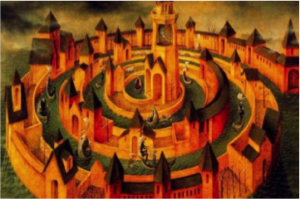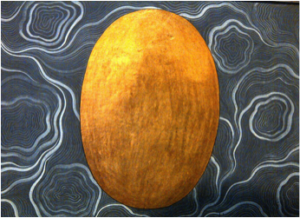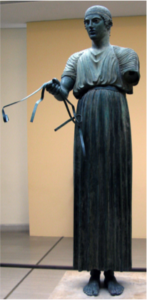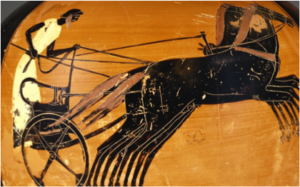 In my last post I invited us all to begin thinking more specifically in terms of the gifts and strengths contributed to the whole by the magic and mythic structures of consciousness. By now we’ve been working in Gebser long enough to see how that popular Wilber cliché, “transcend and include,” in fact merely muddies the waters. The “more primitive” structures of consciousness are not simply folded into the new structure like eggs in a cake batter. Rather, like rooms in a museum, they continue to stand in their own integrity, each with its own center of gravity and way of making connections. They are all needed to create that “paroxysm of harmonized complexity” through which the Integral light can shine.
In my last post I invited us all to begin thinking more specifically in terms of the gifts and strengths contributed to the whole by the magic and mythic structures of consciousness. By now we’ve been working in Gebser long enough to see how that popular Wilber cliché, “transcend and include,” in fact merely muddies the waters. The “more primitive” structures of consciousness are not simply folded into the new structure like eggs in a cake batter. Rather, like rooms in a museum, they continue to stand in their own integrity, each with its own center of gravity and way of making connections. They are all needed to create that “paroxysm of harmonized complexity” through which the Integral light can shine.
This is true on both the micro-and macro-level. It is true in the healing of our own souls, and it is even more true in the healing of our culture. For Gebser, the individual and cultural expressions of evolutionary consciousness are joined at the hip. The outer world is not simply a gateway or metaphor for our inner journey. If anything, the flow is in the opposite direction. Conscious evolution is measured in Gebserian scale by the great movements sweeping across the face of cultural history. What we do here and now, at this crucial turning point, with the cultural institutions entrusted to our stewardship is of paramount importance to how the next chapter of the story will unfold.
So what are the great gifts of these two “earlier” structures of consciousness? As I reflect on Gebser, Jeremy Johnson, and my own seven-decade trek across this terrain (the last three years perhaps more eye-opening than all the rest put together), here is my own short list:
From the magic:
- Vital energy: a powerful, kinesthetic connection to the life force flowing through all things.
- A shapeshifting capacity that allows the observer to easily change places with the observed and hence perceive all things from the inside (because “inside” and “outside” do not yet firmly exist in the much more fluid magical consciousness). In this liminal zone of exchange, stones speak, trees give away their secrets freely, and the great earth spirits draw close to nurture and animate.
- Because of the above, a belly-centered sense of belonging and interbeing; a kinesthetic numinosity which allows the world to be directly sensed as holy, not “reflected upon” as holy.
 A capacity to enter into that deep, non-dimensional “place where there’s no space or time” (to quote Leon Russell); to enter “mindlessness”—and there reconverge as nearly as possible in created form with that fetal archaic consciousness which is not only our personal but the primordial womb.
A capacity to enter into that deep, non-dimensional “place where there’s no space or time” (to quote Leon Russell); to enter “mindlessness”—and there reconverge as nearly as possible in created form with that fetal archaic consciousness which is not only our personal but the primordial womb.
From the mythic:
- “soul:” the headwaters of the river of self-reflective consciousness. The beginning of story.
- A deep sense of nobility, heroism, and virtue.
- The capacity for devotion, covenant, and love—the beginning of “God”; it is in mythic consciousness that Yahweh—“I am who I am”—first announces himself to the Israelite people.
- The capacity to respond to a call from motives beyond mere security and survival: to harness the extraordinary creative strength and self-sacrificial capacities of soul.
- A capacity to find one’s rhythm and ground in the deeper, recurrent rhythms of the great polarities: the seasons, the play of light and dark, rise and fall of tides; opposites expressed not as oppositional, but as simply the fluctuations of a single sine wave.
I believe, by the way, that the mental has great gifts as well, though not the ones we usually look to it for. The speed of processing, calculating, positing, structuring, imagining, world-building speak for themselves. But my own take, strangely, is that what the mental contributes is BACKBONE. Gurdjieff would call it “holy the denying,” second force. Evolution goes “chordate” with the emergence of the mental structure; there is something there which can and does push back. By the very force of our separated consciousness, we can hold our own against the sheer siren call of the Mystery hurtling toward us, singing us back into oneness. We have become, like Jacob wrestling with the angel, wounded but worthy opponents. And this is a painful but absolutely necessary wounding if the next structure of consciousness is to appear, because diaphaneity is impossible if it instantly incinerates the structure it is shining through.
 From Gurdjieff comes another interesting insight. You can say, roughly, that the magic structure corresponds to the moving center (notice how often I use the word “kinesthetic?”), the mythic to the emotional center, and the mental to the intellectual center. And if you permit that analogy, the next step brings an even more interesting insight. Only when the three lower centers are balanced and in communication, Gurdjieff teaches, is it possible for the New Arising (a.k.a., “Conscious Man”) to emerge on this prepared foundation. The bread-and-butter work of conscious transformation in the Gurdjieffian system lies in the careful tending and strengthening of the three lower centers (paying particular care to centers that are weak or neglected in oneself) so that a balanced, prepared undercarriage is in readiness. Then and then only will the higher stage be able to emerge.
From Gurdjieff comes another interesting insight. You can say, roughly, that the magic structure corresponds to the moving center (notice how often I use the word “kinesthetic?”), the mythic to the emotional center, and the mental to the intellectual center. And if you permit that analogy, the next step brings an even more interesting insight. Only when the three lower centers are balanced and in communication, Gurdjieff teaches, is it possible for the New Arising (a.k.a., “Conscious Man”) to emerge on this prepared foundation. The bread-and-butter work of conscious transformation in the Gurdjieffian system lies in the careful tending and strengthening of the three lower centers (paying particular care to centers that are weak or neglected in oneself) so that a balanced, prepared undercarriage is in readiness. Then and then only will the higher stage be able to emerge.
Now it seems to me that this is a very good clue as to where our attention needs to be, not only personally but even more, culturally. We need to tend, balance and consciously connect those three lower structures we have been entrusted with: the magic, mythic, and mental.
Gurdjieff often conveyed this teaching in the form of a metaphor about a horse (emotional center), carriage (moving center), driver (intellectual center) and owner (“Real I, or conscious human being.) At the present moment, he said, the carriage is disrepair, the horse’s reins have vanished, the driver is at the pub, and the owner is nowhere to be seen.
It’s not a long stretch to apply this to our own North American cultural landscape, Winter, 2021. The magic structure is missing its brakes; the mythic structure, having cut the cord with the mental, has wandered off into the poppy fields; the driver is at the pub of choice, gulping down the home brew in fiercely loyal draughts; and the Owner—the emergent Integral— is huddling in a corner, frantically texting Uber rather than risking his life to such a contraption. We can and must do better.
I ask us all: how do we begin to help restore the carriage and horse: the sturdy—albeit perhaps “antiquated” magical and mythical institutions of our culture so dismissively cast aside, even in our own lifetime, by a street-smart driver who’s sure she knows what is best? What are these structures, anyway? Where do we locate them? If the values they represent (as per my list above) are crucial to the emergence of the Integral—and even in the event that they can be gently disentangled from the cultural institutions that have borne them for so long and be revivified in other ways, by no means a foregone conclusion—how do we find the heart and the forgiveness for this work? How do we sober up from our smug dismissiveness, pick up the currying brush, and start again with the work that must be done, for the sake of the whole, for the sake of the future?
Please see Cynthia’s Afterword: Exploring Jean Gebser Lesson X, where she is hearing resonances: “Trying to understand how to reconnect, rebalance and re-honor the severed magic, mythic, and mental structures in our culture is a gargantuan task, beyond any single one of us. But I already hear you…”
Images from the top: Saint Theresa’s Interior Castle, author unknown, courtesy of Integrated Catholic Life; Pahari painting of Golden cosmic egg Hiranyagarbha by Manaku, c. 1740, courtesy of wikipedia; Charioteeer of Delphi, cropped, image author Юкатан, courtesy of wikimedia commons; Attic Panathenaic amphora, Kleophrades Painter, 490-480 B.C, public domain.


In the words of Gurdjieff, this wise achering. Let’s just way too many words , Wiseachering.Use the memory stone. In the words of Thomas Keating silence is God’s first language, everything else is poor translation. Remember yourselves always and everywhere and remember to practice your preferred meditation sitting practice twice a day as your ceaseless prayer in The cloud of unknowing.
Some comments now reading this a second time:
1. Please say more about how it’s possible that the last 3 years have been more revelatory than the first 6 decades put together? How.is.that.possible?
2. The mental gift is giving us “backbone” is an intriguing idea. You have often said that we need to build up the “nervous system” in order to “bear the beams of love” (Blake), by which I had always thought that the way to do that was through meditation, the Welcoming Prayer (going down into sensation rather than up into story), and various physical practices (chigung, yoga, proper breathing techniques – anything in the body center). Is mental “backbone” and building up the nervous system the same, different, or related aspects of “Jedi training?”
3. Needing that backbone is also a very important point. This is a great reminder, as you yourself have said explicitly in the study of Gebser, for us not to apologize or wish away the mental structures, which to be honest is hard to do because so much of not just Eastern practices, but now Western approaches, too, always stress how the mental structures are the biggest impediment to spiritual life. As you said in Wisdom Way of Knowing, it’s like using a chainsaw to play the violin – the wrong tool for the job. Especially for those mindy 5s, 6s, and 7s on the enneagram, we wish we could just be done with the whole mental overactivity and get on with the show! But that, too, requires subtle discernment, for the mental has its own gifts we don’t want to deny. But it’s hard to get that balance right.
4. “Evolution goes chordate” – after looking that up, I realized, wow, that is SUCH a great metaphor…because it is physiologically true that we have gained a great deal in standing upright, but we’ve lost the earlier gifts, too. Our sense of smell, for instance, has atrophied now that we are not so close to the ground. Certainly it is standing up that allows us to have the “perspectival” approach at all. We can consider the big picture, but that gives us a distance that separates us the magical and mythical.
5. If I can suggest that this would be another way to use the Enneagram with the 8-9-1 instinctive triad helping us redevelop the kinesthetic dimensions, the 2-3-4 triad reminding us of the heart center, and 5-6-7 giving us that “holy denying” force. Or for that matter, the base, sacral and solar plexus chakras are the kinesthetic; the heart and throat are the emotional center; and the brow and crown are the mental.
At this point, I’ll tag on a revision of what I wrote on FB a few days ago about HOW to do this from a practical point of view. What practices are available to take this from the page to implementation?
6. About a year ago, following a brief meditative grounding, I asked my mind, my heart, and my body (in that order) a question about my own personal future and just sat at my computer and typed out a response. While I generally consider myself to be something of a brick in such intuitive practices, I was pretty shocked what tumbled out in full sentences (which I have in my files): the mind spoke with utter clarity; the heart spoke of its own accord by forgetting the question but speaking of its own deep matters; and the body downloaded striking words of opaqueness that still evoke mystery and gravitas. Maybe you could try this at a retreat or Wisdom School setting.
7. Finally, I’m in training to become an energetic kinesiology practitioner. As I’m reading the magical description above especially, my own most vivid examples come from my kinesiology practice. Our disciplined approach to the body is principally in this magical domain, although it certainly has a very clear “holy denying” aspect in that the process does not appear to be “woo woo” in any way, even if the outcomes are jaw-dropping.
In this sense, it is a working model of the magical, mythic, and mental working seamlessly, with the magical/body center the wheel around which the other two spin. When doing kinesiology, the practitioner’s and client’s bodies stay in constant contact – that’s the most important conversation – with occasional explicit conversion of body indicators into actual language. So, body-based muscle tests lead occasionally to various “psycho-emotional responses” (for example, “can’t learn from past mistakes”) that combine the mythic and the mental; at other points, archetypes (e.g, Zeus is about one’s overmastery of a situation) can be used to see which of these “energetic frequencies” speak to the body. This is just the beginning. Certainly the 3Ms could be applied to kinesiology practice because they are all frequencies that the body can respond to.
This energetic kinesiology – a millennia-in-the-making combination of Chinese Taoist-based meridian systems, the Indian chakra nadi system, and Western anatomy and physiology – verifies precisely what you are saying about how the 3M’s work together for the purposes of healing and transformation. In fact, all 3M’s – drawing on three Wisdom traditions – are working in a concerted, orderly state of “harmonized complexity.” (No “paroxysm!”) What you are saying aren’t just nice words to me, but becoming a lived practice.
My own dream is to complement this primarily body-based practice (body-centric or magical) with the Enneagram (mind-centric or mental) and spiritual practices (heart-centric or mythical). Kinesiology is a quite passive reading of the body by a practitioner, the enneagram is an active mental process, and spiritual practice are the daily, heart-based practices that take the body and mind-based inputs from kinesiology and enneagram respectively, and integrate them in the self holistically.
I appreciate Cynthia’s unpacking of this material and the invitation to play with it. Her insight around the three centers needing to be balanced (and in communication) before a new arising can occur, causes me to wonder where the centers have been getting some exercise.
I don’t know if I’m using the concepts well, but I’d like to try them out using Cynthia’s descriptors.
I’ve been wondering what someone with a longer perspective might see in our 2020. Yes, it will be a year remembered for unprecedented low points, but there are other things I’ve noticed. I’ve been keeping a list: 2020, the year of the nurse, the neighbor, the scientist, the voter, and the county clerk.
Was it our magic center that infused the following?
How (with 2.3M dead from a new breath stealing disease) could it have not caused millions to wrestle with the grief and gift of the life that flows through all things. At the very least, many humans have given that life force their attention and reflected on its power.
Did you notice something liminal about the gatherings to publicly grieve and protest George Floyd’s killing? And did you notice that while the profile of the victims remain distinctly black and male, the profile of the protesters got more diverse? Is it a valid use of the shapeshifting capacity to apply it to the phenomenon where people begin exercising their ability to hold another group’s perspective?
When the pandemic disrupted people’s routines, entertainments, and consumptions in large scale ways, many sought refuge on hiking trails, seashores, and open places. I wonder if there was not an upsurge in a population’s direct sense of the holy.
Was it our mythic center that lots of people used to find their sense of nobility, heroism, and virtue?
What were doctors, nurses, and care takers doing when they quickly discovered they had no cure? From what I can tell, they stuck with it. They offered care and company. They bore witness to the humanity of the individual dying alone in front of them.
And who are these scientists who went to work in the face of such odds? A vaccine for a novel virus (or maybe 3 or 4 vaccines) created in the span of a year? There is something noble and virtuous about the kind of people who join in the creative, collaborative, humbling, disciplined, and mostly anonymous work of listening to a disease and developing a response.
And speaking of unglamorous professions, I’ve met a few county clerks. As a group I’ve known them to approach transparency, counting, and non-partisanship like a solemn vow. It is the stories we tell ourselves about the importance of defending ideas and principles that is what the mythic center offers, right? It’s been a long time since I used the word ‘patriot’ with a sincere heart, but I found myself using it as the best word in my vocabulary to describe their kind of quiet honor.
And the voters of 2020. People showed up in droves to cast their one, solitary vote. And, yes, I recognize that a lot of pundits see a deep divide, but I wonder if there is also something else to see. I think a large number of voters moved beyond their own self-interest to a motive for preserving and protecting a common good.
Thank you, Cynthia, for allowing a space to work on this. I do also really love the image of Jacob wrestling with the angel. No chance we are getting out of this without wounds.
Dear Cynthia,
This morning I considered just where I might post this – then came your timely blog post. Only two nights ago I watched the film “Meetings with Remarkable Men” by happenstance. And in writing just now, it occurred to me the value of the film quote (spoken to Gurdjieff):
“You have found your place my son. You come like a lamb, but, don’t forget you have a wolf in you as well. Look, can you find the force to enable these two quite opposite lions to live within yourself? Listen carefully. This won’t happen by itself. It is not enough to think about it, to dream, to wait – at anytime the wolf can devourer the lamb. And, you must learn what it means to become responsible. This is an exact science, and that is why you are here. I will not put you in the hands of someone you can not feel complete trust.”
I offer the trustworthy hands of Vandana Shiva and Robert F. Kennedy Jr., dialoging here the overt mechinations of truly unremarkable men. In so hearing this “you must learn what it means to become responsible.” We are living in remarkable and perilous times that require humility, courage, and conscious suffering (as you Cynthia have so stridently conveyed).
https://childrenshealthdefense.salsalabs.org/2-8-21defender?wvpId=0549f378-ffbb-451a-bb70-82c2639d98dc
2 Timothy 3 (KJV)
3 This know also, that in the last days perilous times shall come. 2 For men shall be lovers of their own selves, covetous, boasters, proud, blasphemers, disobedient to parents, unthankful, unholy, 3 without natural affection, trucebreakers, false accusers, incontinent, fierce, despisers of those that are good, 4 traitors, heady, highminded, lovers of pleasures more than lovers of God; 5 having a form of godliness, but denying the power thereof: from such turn away. 6 For of this sort are they which creep into houses, and lead captive silly women laden with sins, led away with divers lusts, 7 ever learning, and never able to come to the knowledge of the truth. 8 Now as Jannes and Jambres withstood Moses, so do these also resist the truth: men of corrupt minds, reprobate concerning the faith. 9 But they shall proceed no further: for their folly shall be manifest unto all men, as theirs also was.